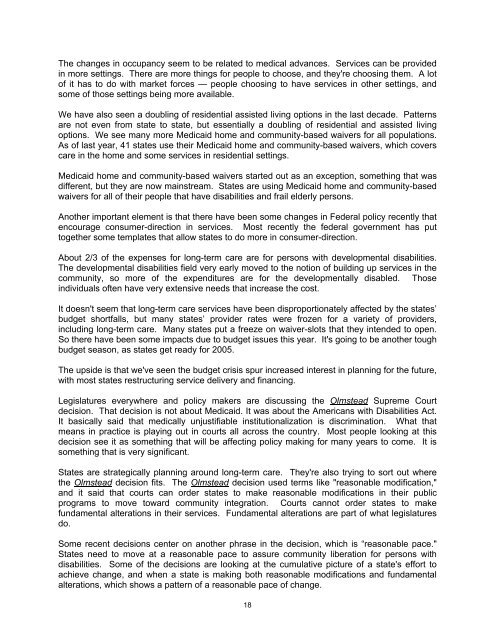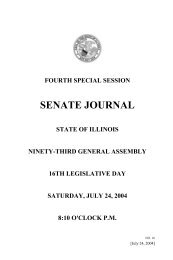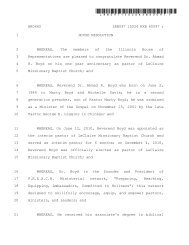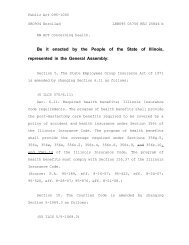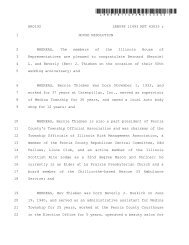Long-Term Care - Illinois General Assembly
Long-Term Care - Illinois General Assembly
Long-Term Care - Illinois General Assembly
You also want an ePaper? Increase the reach of your titles
YUMPU automatically turns print PDFs into web optimized ePapers that Google loves.
The changes in occupancy seem to be related to medical advances. Services can be provided<br />
in more settings. There are more things for people to choose, and they're choosing them. A lot<br />
of it has to do with market forces — people choosing to have services in other settings, and<br />
some of those settings being more available.<br />
We have also seen a doubling of residential assisted living options in the last decade. Patterns<br />
are not even from state to state, but essentially a doubling of residential and assisted living<br />
options. We see many more Medicaid home and community-based waivers for all populations.<br />
As of last year, 41 states use their Medicaid home and community-based waivers, which covers<br />
care in the home and some services in residential settings.<br />
Medicaid home and community-based waivers started out as an exception, something that was<br />
different, but they are now mainstream. States are using Medicaid home and community-based<br />
waivers for all of their people that have disabilities and frail elderly persons.<br />
Another important element is that there have been some changes in Federal policy recently that<br />
encourage consumer-direction in services. Most recently the federal government has put<br />
together some templates that allow states to do more in consumer-direction.<br />
About 2/3 of the expenses for long-term care are for persons with developmental disabilities.<br />
The developmental disabilities field very early moved to the notion of building up services in the<br />
community, so more of the expenditures are for the developmentally disabled. Those<br />
individuals often have very extensive needs that increase the cost.<br />
It doesn't seem that long-term care services have been disproportionately affected by the states’<br />
budget shortfalls, but many states’ provider rates were frozen for a variety of providers,<br />
including long-term care. Many states put a freeze on waiver-slots that they intended to open.<br />
So there have been some impacts due to budget issues this year. It's going to be another tough<br />
budget season, as states get ready for 2005.<br />
The upside is that we've seen the budget crisis spur increased interest in planning for the future,<br />
with most states restructuring service delivery and financing.<br />
Legislatures everywhere and policy makers are discussing the Olmstead Supreme Court<br />
decision. That decision is not about Medicaid. It was about the Americans with Disabilities Act.<br />
It basically said that medically unjustifiable institutionalization is discrimination. What that<br />
means in practice is playing out in courts all across the country. Most people looking at this<br />
decision see it as something that will be affecting policy making for many years to come. It is<br />
something that is very significant.<br />
States are strategically planning around long-term care. They're also trying to sort out where<br />
the Olmstead decision fits. The Olmstead decision used terms like "reasonable modification,"<br />
and it said that courts can order states to make reasonable modifications in their public<br />
programs to move toward community integration. Courts cannot order states to make<br />
fundamental alterations in their services. Fundamental alterations are part of what legislatures<br />
do.<br />
Some recent decisions center on another phrase in the decision, which is “reasonable pace."<br />
States need to move at a reasonable pace to assure community liberation for persons with<br />
disabilities. Some of the decisions are looking at the cumulative picture of a state's effort to<br />
achieve change, and when a state is making both reasonable modifications and fundamental<br />
alterations, which shows a pattern of a reasonable pace of change.<br />
18


